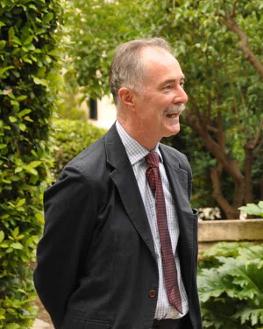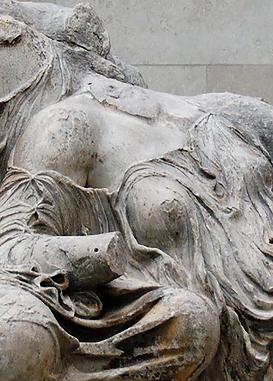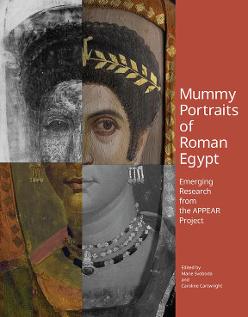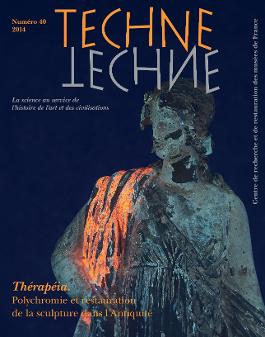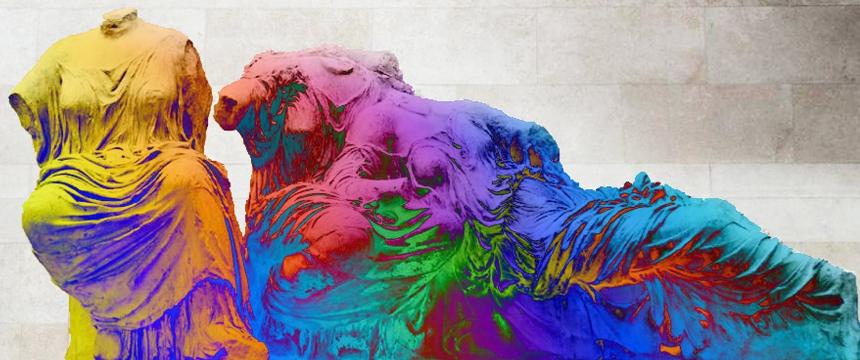
Latest News
Call For Papers: Cahiers De Mariemont - Vol. 47, "The Lost Colours of Ancient Sculptures: Identifying, studying, interpreting, and promoting ancient polychromy in Museums"
Since 2021, the Royal Museum of Mariemont has been actively participating in the interdisciplinary "PolyChroma" project, which aims to examine the social significance of the colours used in Roman sculpture, in collaboration with Elisabetta Neri (Università degli Studi di Firenze) and David Strivay (Centre européen d'archéométrie, Liège): https://www.polychroma.uliege.be/cms/c_6264927/en/polychroma
In anticipation of a project to showcase the results in Mariemont, the upcoming issue of the Cahiers de Mariemont journal will be dedicated to "The lost colours of ancient sculptures" and their research and exhibition in museums. We are excited to share the call for papers and seek your valuable input in exploring the methods for identifying colours, addressing the challenges of chromatic interpretation, and discussing the implications of making the lost colours of ancient statues accessible in museums.
Deadline 15th October 2024.
Added: 13/09/2024
Project News! Illusion and allusion. Rediscovering colours in Roman and early medieval architecture
The biennial project (Università Cattolica del Sacro Cuore, Milan; Università di Torino) is supported by the Italian Ministry of University and Research and constitutes a pilot research on the constituent characteristics of the ‘skin’ of Roman and early medieval buildings in north-western Italy: the original colour and treatment of masonry surfaces and structural/decorative components are a key part of fragile, crumbling architecture of which only fleeting traces often remain. The study of the architectural complex as a whole (traces of polychromy on elements of architectural decoration/structures and finishing techniques of masonry facings) is crucial for reconstructing the original appearance of architectural heritage and understanding how it was perceived in its era, an immaterial aspect that should not be ignored in the investigation of the past. The focus is therefore colour, both that of the material itself but especially the colour applied to surfaces with various techniques, which conditions the interpretation of decorative and structural details, generating phenomena of illusion and allusion, the significance of which changes over time.
Added: 09/04/2024
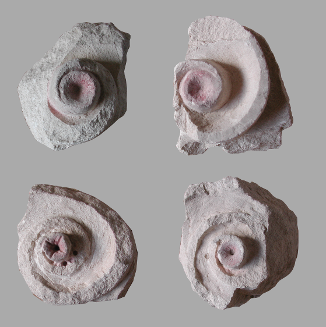
Painted fragments of Vicenza stone ionic capitals from the Roman villa of Sirmione, Italy. Image © Furio Sacchi
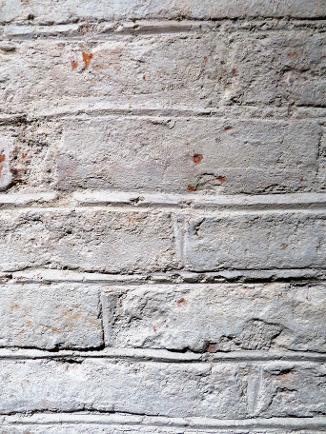
Detail of a pillar from the Basilica of Saint Simplician in Milan, Italy. Image © Paola Greppi
"The Role of a Replica": New exhibit at The Parthenon in Nashville, Tennessee
With a focus on the Parthenon sculptures, The Role of a Replica is a hands-on, interactive exhibition exploring the ways in which historical and artistic replicas can illuminate our lost history. The exhibition illustrates how these replicas are currently used to communicate the latest archeological discoveries and interpretations. Interactive displays teach museumgoers how molds and casts of fragments of ancient statuary can be used to reconstruct their original appearance within their original architectural context. It also shows how modern scientific investigations can reveal lost colors on ancient statuary. Plaster casts, archival materials, and other resources and technologies can help researchers to reconstruct fragmented sculptures.
For more information see the exhibit page:
https://www.nashvilleparthenon.com/events/role-of-a-replica
Digital resources page:
https://www.nashvilleparthenon.com/replica
Added: 13/10/2023
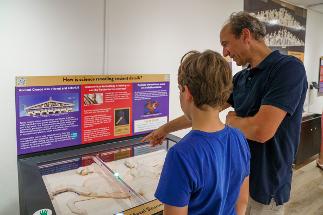
Image courtesy of the Parthenon. Photo: Von Resich Photography.
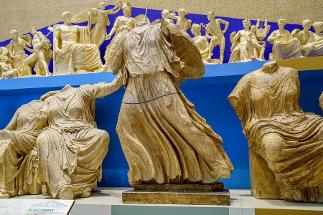
Image courtesy of the Parthenon. Photo: Von Resich Photography.
New exhibition “Machine Room of the Gods. How Our Future Was Invented” at Liebieghaus Skulpturensammlung extended until Jan 2024!
The Liebieghaus Skulpturensammlung is devoting an exhibition to one of the most exciting connections in the history of mankind – the connection between art and technology. It is a global narrative, full of cryptic fables, myths and visions, fictive and real innovations and outstanding masterworks. The exhibition will shed light on the history of the sciences in antiquity and the Arabic and Asiatic cultures and their influence on the development of art.
The Frankfurt exhibition will feature 97 prominent objects from international museum collections such as the Museo Archeologico Nazionale in Naples, The Metropolitan Museum of Art in New York, the Musei Capitolini in Rome and the Kunsthistorisches Museum in Vienna, as well as from the Liebieghaus Skulpturensammlung’s own holdings. The multimedia exhibition architecture will transform the entire Liebieghaus into a museum in which art and science of more than five millennia come to life.
Curator: Prof. Dr. Vinzenz Brinkmann (Head of the Department of Antiquities and Asia, Liebieghaus Skulpturensammlung)
More information here.
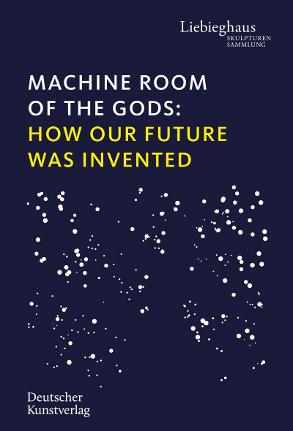
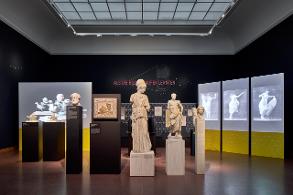
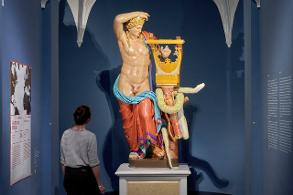
PRT11 Publication News!
The Sovrintendenza Capitolina and the Museo Nazionale Romano have kindly agreed to publish the proceedings of the 11th International Round Table on Polychromy in Ancient Sculpture and Architecture, held in Rome on 9th – 12th November, 2022.
The volume will be published as a Supplement to the Bullettino della Commissione di Archeologica Comunale di Roma, one of Rome’s oldest archaeological journals. The expected publication date is yet to be confirmed.
Added: 27/07/2023
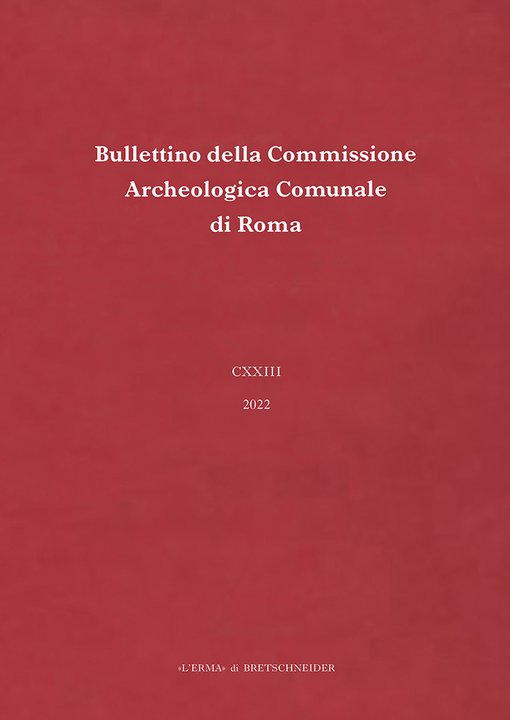
Project News! Conservators at the Kelsey Museum of Archaeology launch project website, Investigating Color in Roman Egypt
Carrie Roberts and Suzanne Davis, conservators at the Kelsey Museum of Archaeology at the University of Michigan, have recently launched a website that features some of the outcomes of their NEH-funded technical survey of pigments and dyes in the Museum’s Roman Egyptian collection. The site shares their project’s research methods (available for download) as well as a series of case studies from the 150+ objects that were examined, imaged, and analyzed as part of the study. Roberts and Davis hope that by making these research tools and findings widely available, researchers working at smaller institutions will feel inspired to pursue technical color studies in their own collections. Plans are underway to publish the results of the technical survey on scholarly platforms.
Visit the website here:
https://sites.lsa.umich.edu/color-roman-egypt/
Added: 08/06/2023
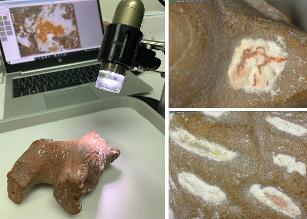
Digital microscopy of KM 6909, terracotta dog figurine, showing traces of yellow and pink paint over a white ground.
Image © The Kelsey Museum of Archaeology.

Digital color reconstruction of KM 6909 (artifact case study featured on website).
Image © The Kelsey Museum of Archaeology.
Project News! IPERION HS MOLAB campaign on the Hunt Frieze on the façade of the Tomb of Philip II at Aigai
From 8 to 27 March 2023 the first phase of the interdisciplinary, non-destructive scientific investigation of the Hunt Frieze that adorns the façade of the Tomb of Philip II took place at the archaeological site of Aigai (UNESCO monument). The study is part of the research project ReVis (Principal Investigator: Hariclia Brecoulaki), funded by the Hellenic Foundation for Research and Innovation (HFRI). The project is carried out by the Institute of Historical Research of the National Hellenic Research Foundation, in collaboration with the XRF Laboratory of the Institute of Nuclear and Particle Physics – National Centre for Scientific Research “Demokritos”, and the Ephorate of Antiquities of Emathia – Ministry of Culture and Sports. In terms of research infrastructure, ReViS is also supported by the MOLAB (Mobile Laboratory)/IPERION HS consortium. The collaborating institutions are the XRAYlab of the Istituto di Scienze del Patrimonio Culturale (ISPC), Consiglio Nazionale delle Ricerche (CNR) in Catania, the Centro di Eccellenza SMAArt, Università degli studi and the Istituto di Scienze e Tecnologie Chimiche “Giulio Natta”, CNR, in Perugia.
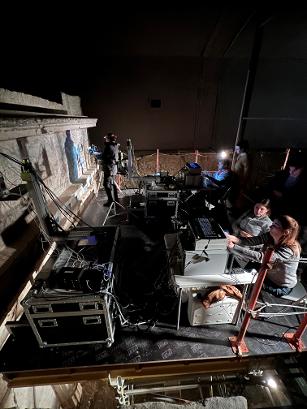
XRAYlab, Istituto di Scienze del Patrimonio Culturale (ISPC), Consiglio Nazionale delle Ricerche (CNR) in Catania on the scaffolding in front of the Tomb of Philip II at Vergina.
Image © H. Brecoulaki/Ephorate of Antiquities of Emathia, Ministry of Culture and Sports.
The research project entitled “The Hunt Frieze of Tomb II at Vergina, Greece: A Novel Interdisciplinary Approach for the Scientific Investigation and Revisualization of a Painted Masterpiece of the Classical World” is supported by the Hellenic Foundation for Research and Innovation (H.F.R.I.) under the “2nd Call for H.F.R.I. Research Projects to support Faculty Members & Researchers” (Project Number: 4366).
Added: 06/04/2023

Dr Tuna Şare Ağtürk awarded the James R. Wiseman Book Award for her monograph, The Painted Tetrarchic Reliefs of Nicomedia: Uncovering the Colourful Life of Diocletian’s Forgotten Capital.
The Archaeological Institute of America (AIA) has awarded Dr. Tuna Şare Ağtürk the 2023 James R. Wiseman Book Award for her monograph, The Painted Tetrarchic Reliefs of Nicomedia: Uncovering the Colourful Life of Diocletian’s Forgotten Capital. The monograph is published in the series Studies in Classical Archaeology, edited by professor and UrbNet centre director Rubina Raja and published by Brepols Publishers.
The book is the primary publication of a major new monument of the Tetrachic period from Nicomedia in Asia Minor. Read more about the book at Brepols’ website here.
Added: 10/01/2023
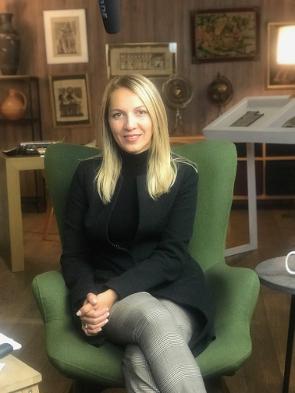
Image © Archaeological Institute of America (AIA).
PRT12 - Save the Date!
The 12th International Round Table on Polychromy in Ancient Sculpture and Architecture will be held at the Getty Villa in Los Angeles, California, USA, during the week of 18th November, 2024.
More details to follow soon!
Updated: 12/12/2022
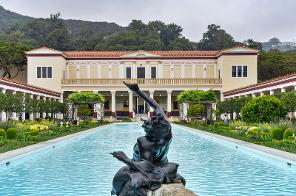
Alexandra Rodler receives ERC funding for her project "Color in a New Light ‒ Origins, Trade and Cultural Significance of Ancient Pigments"
The project funded by the European Research Council (ERC) for a duration of 5 years will be based at the Austrian Archaeological Institute (OeAI) in Vienna. The goals of the project include developing a comprehensive approach to assessing the origin of raw materials, trade and technological developments of pigments in antiquity and with this, the significance of colour in cultural contexts. At its core, this project develops an open access database and uses the collected data to evaluate pigments as carriers of cultural information, as well as for the visualisation of colour networks.
Read more about the project here.
Added: 25/11/2022
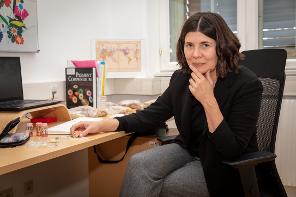
Image © OeAW-OeAI/N. Gail
Project News! Ancient polychromy and terracotta technology in the Sanctuary of Athena at Castro (Lecce)
Systematic archaeological research carried out since 2000 brought to light the ancient sanctuary of Athena in the indigenous settlement of Castro (Lecce), on the southern Adriatic coast of Italy. The research project has been developed by the University of Salento (Prof. D’Andria), the local Soprintendenza and the Municipality of Castro.
The discovery of a colossal statue of Athena in local limestone (350-300 BC), some gigantic relief slabs decorated with ‘peopled’ scrolls (350-300 BC), Doric frieze blocks of a late Classical calcarenite monument and fragments from a late Archaic clay roof of a monumental temple (about 520 BC) have allowed the beginnings of an in-depth investigation on the local craft productions.
A recent E-RHIS-IT MOLAB access, (AthenaInColor project), coordinated by ISPC-CNR (National Research Council – Institute of Heritage Science), offered the opportunity to investigate ancient polychromy, terracotta and stone technology, benefiting from the exceptional state of conservation of the archaeological materials. Since the potential of an archaeometric approach to these craft productions has been so far neglected, this research aimed to fill the gap on the technical know-how of Magna Graecia artisans.
An analytical protocol based on imaging techniques (VIS, UVL/VIL) combined with single spot techniques (p-XRF, External reflection mid-FTIR, Raman and UV-VIS_NIR spectroscopy) was conducted in order to detect traces of ancient polychromy. Besides the identification of yellow and red ochres, Egyptian blue and the presence of preparatory layers, UVL observations demonstrated the extensive use of organic treatments on all the finished limestone surfaces, a technological solution not attested so far for limestone sculptures in Magna Graecia.
Further analyses will be performed on the newly discovered lower part of the Athena statue, which shows clear evidence of colors on the garments.
Added: 07/11/2022.
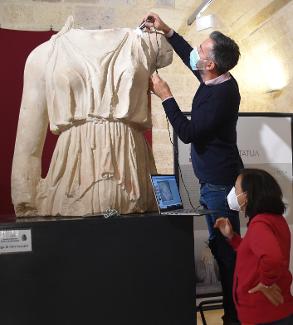
Image © ISPC-CNR
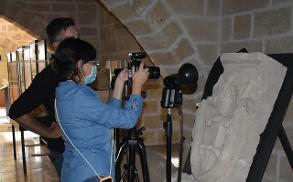
Image © ISPC-CNR
Welcome to new PRT Web Team Member, Dr Eleni Aggelakopoulou!
Dr Eleni Aggelakopoulou joins the PRT Web Team this month as its newest member! She is a chemical engineer, and holds an MSc in the “Protection of Monuments: Materials and Restoration Interventions” and a PhD in the field of “Restoration mortars design for historic structures”. Currently, she works in the Acropolis Restoration Service (YSMA) of the Hellenic Ministry of Culture and Tourism, as the Head of the Technical Office for the Acropolis Monuments Surface Conservation. In the past, she has worked as a researcher in the School of Chemical Engineering of the National Technical University of Athens.
More information on her work and research interests here. See also here.
Added: 13/06/2022

Image © Eleni Aggelakopoulou
New exhibition "Chroma: Ancient Sculpture in Color" at The Metropolitan Museum of Art opens in July
The exhibition presents new discoveries of surviving ancient color on artworks in The Met’s world-class collection and explores the artistic practices and materials used in ancient polychromy. Highlighting cutting-edge scientific methods used to identify ancient color, Chroma examines how color helped convey meaning in antiquity, and how ancient polychromy has been viewed and understood in later periods.
The exhibition will feature a series of reconstructions of ancient sculptures in colour by Prof. Dr. V. Brinkmann, Head of the Department of Antiquity at the Liebieghaus Skulpturensammlung, and Dr. U. Koch-Brinkmann, and introduces a new reconstruction of The Met’s Archaic-period Sphinx finial, completed by the Liebieghaus team in collaboration with the Met's Departments of Greek and Roman Art, Objects Conservation, Scientific Research and Imaging. Presented alongside original Greek and Roman works representing similar subjects, the reconstructions are the result of a wide array of analytical techniques, including 3D imaging and rigorous art historical research.
More information here.
Added: 25/05/2022.
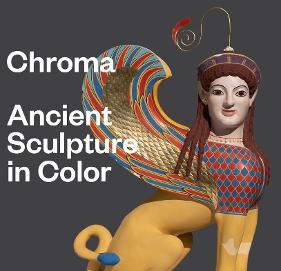
Reconstruction of marble finial in the form of a sphinx (detail), 2022. 3D print in polymethyl metacrylate, natural pigments in egg tempera, gilded copper, gilded tin. Liebieghaus Skulpturensammlung (Liebieghaus Polychromy Research Project), Frankfurt am Main; original: Greece, ca. 530 B.C. The Metropolitan Museum of Art, New York (11.185d, x).
Image © The Metropolitan Museum of Art.
Webinar to honour the late Dr. Susanna Bracci (ISPC-CNR)
Tuesday 24th May, 2022. 9.00-12.30 CET
A webinar is scheduled for the morning of Tuesday 24th May as a tribute to the research activities of the late Dr. Susanna Bracci of ISPC-CNR.
Please note that the webinar will be in Italian.
More information of the program of the day here.
The event was recorded. See "Past Events" for links.
Added: 16/05/2022.
New exhibition "Persia: Ancient Iran and the Classical World" opens at The Getty Villa Museum.
This exhibition is part of the Getty Museum’s program The Classical World in Context, and explores the artistic and cultural connections between the rival powers of Iran, Greece, and Rome. Works on view include royal sculpture, spectacular luxury objects, religious images, and historical documents assembled from major museums in the United States, Europe, and the Middle East. More information here.
Also available is a website experience allowing for in-depth exploration of the magnificent palace complex of Persepolis and objects featured in the exhibition.
Added: 19/04/2022.
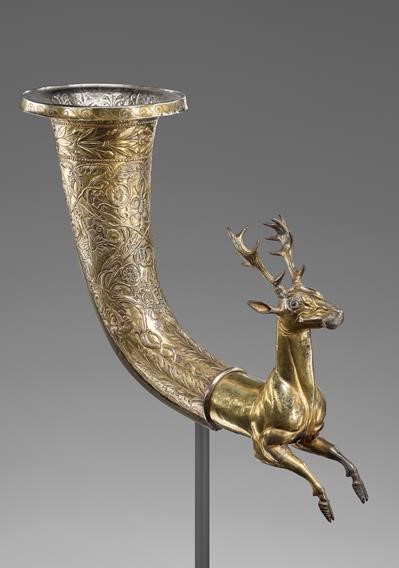
Stag Rhyton, 100--B.C., Parthian. Gilt silver, garnet, glass.Image © Getty Museum
The 3rd and 4th papers in the Heritage special issue, "Polychromy in Ancient Sculpture & Architecture", have been published!
Congratulations to Eleni Aggelakopoulou, Sophia Sotiropoulou & Georgios Karagiannis on their paper on "Architectural Polychromy on the Athenian Acropolis: An In Situ Non-Invasive Analytical Investigation of the Colour Remains" and to Elisabetta Neri, Nesrine Nasr & David Strivay on their article on "Ancient Restoration in Roman Polychromy: Detecting Aesthetic Changes?"
Read these and other articles in this special issue, free and open access, here. More coming soon!
Added: 06/04/2022.
BLUENET: A new research network for Egyptian blue!
In June 2021, a research network called BLUENET was created by Antonio Sgamellotti, Professor Emeritus at Perugia University and member of the Accademia Nazionale dei Lincei, following the exceptional discovery by his research group, of the Egyptian blue pigment in Raphael’s fresco, “The Triumph of Galatea” (1511-12) at Villa Farnesina, Rome, the headquarters of the Accademia Nazionale dei Lincei.
Such an unexpected finding after centuries of oblivion, currently the first finding dated to the Renaissance period, has posed many question about the provenance of this Egyptian blue, and whether its use by Raphael was the tip of the iceberg in an underground but continuous production, or a freshly-produced batch to satisfy the urbinate master's well-known passion for the Antique and thorough knowledge of the classical sources.
BLUENET was thus established to study the chronology of Egyptian blue use, its geographical spread through manufacturing features, such as its major and minor components, and the extensive census of its presence in artworks through non-invasive techniques. To date, BLUENET has gathered about 70 institutions and 115 researchers excited to share their work about Egyptian blue. Read more here.
The first BLUENET conference, "BLUENET 2022", will be held in Rome, at the Accademia Nazionale dei Lincei and at the Archaeological Park of the Colosseum on 5th October, 2022. The program is being defined and will be announced shortly.
For more info contact: bluenet2020@libero.it
Added: 15/03/2022.
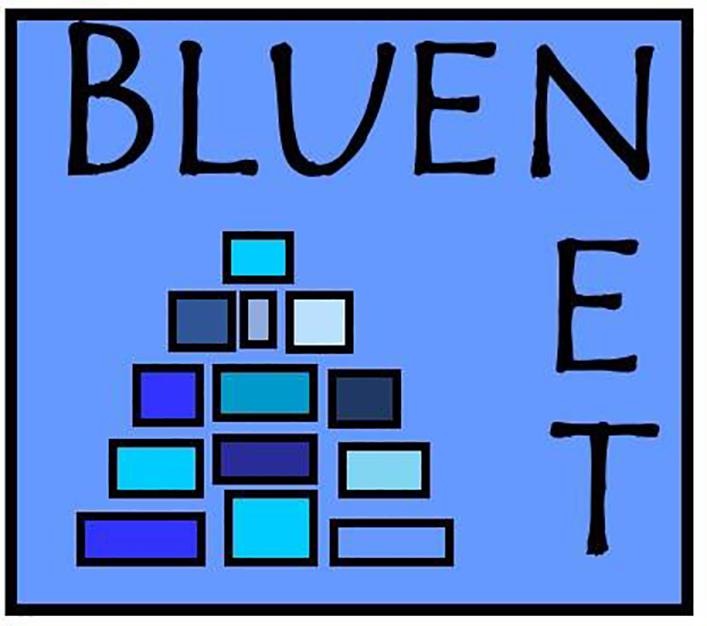
The BLUENET logo
Image: courtesy of BLUENET
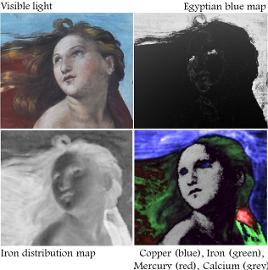
Detail from the Triumph of Galatea, showing the distribution of Egyptian blue and of the main chemical elements obtained with non-invasive analyses.
Image: courtesy of Villa Farnesina.
New Project! Colours Revealed – Polychromy Of Roman Monuments In The Danube Provinces (Polychromon)
The Polychromon project, based at the Austrian Archaeological Institute, aims at a comprehensive investigation of the polychromy of Roman stone artefacts in the Noric-Pannonian region. In interdisciplinary cooperation, aspects such as polychromy as a means of visual design, ancient colour symbolism or the use of different painting techniques will be investigated. A special research focus is on objects of the Mithras cult from Carnuntum and the Vienna Basin and the significance of colour in a religious and ritual context.
Read more here.
Added: 04/03/2022
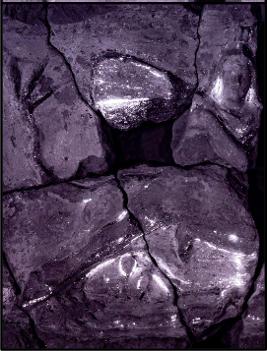
Multispectral analysis of a tauroctony relief in Carnuntum (AMC Inv. CAR-S-99).
Image© OeAI-OeAW, photo: R. Krickl.
Spotlight on IPERION HS: Call for proposals to access transnational platforms
IPERION HS is a consortium of 24 partners from 23 countries that contributes to establishing a pan-European research infrastructure on heritage science. It offers training and access to a wide range of high-level scientific instruments, methodologies, data and tools for advancing knowledge and innovation in heritage science.
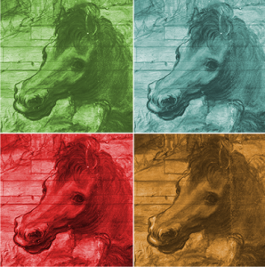
Call for proposals
IPERION HS offers free-of-charge access to more than 100 state-of-art scientific techniques and 14 archives, distributed in 16 countries via three advanced transnational platforms; ARCHLAB (for access to scientific archives), FIXLAB (for access to research facilities) and MOLAB (for access to mobile equipment). IPERION HS selects the best proposals through peer-review and covers the costs of this activity.
Proposals must be submitted online through the application form, at any time, with two evaluation cut-off deadlines a year.
4th call deadline: 29th April 2022 – 11:59 pm Rome time zone
More information here.
Added: 04/02/2022.
New exhibition "Pompeii in Color: The Life of Roman Painting" opens at the Institute of the Ancient World (ISAW) in New York
The exhibition, which opened on January 26th and runs until May 29th, presents thirty-five frescoes from the National Archaeological Museum of Naples.
For more information visit: http://www.pompeiiincolor.com/
Added: 30/01/2022.
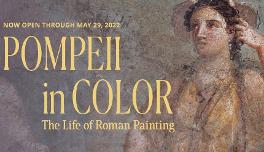
Deadline extended for the special issue of Heritage on "Polychromy in Ancient Sculpture and Architecture"
The special issue, which will collect contributions to the 9th Polychromy Round Table & also invites articles from researchers who may be considering ancient polychromy from the Greco-Roman world & comparative studies from their own interdisciplinary viewpoints, geographical areas & time periods, now has a new deadline for submissions of 31st July 2022.
For more information, see:
https://www.mdpi.com/journal/heritage/special_issues/polychromy_sculpture_architecture
Added: 06/01/2022
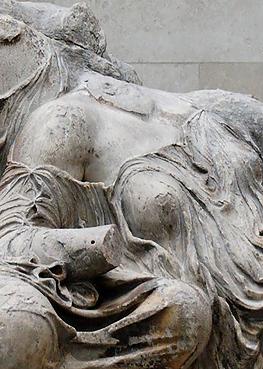
New 3-D digital reconstruction of the statue of Athena Parthenos unveiled as part of the Museum of Fine Arts, Boston (MFA) new Ancient World galleries
The Museum of Fine Arts, Boston (MFA), unveiled its transformed George D. and Margo Behrakis Wing for Art of the Ancient World: five reimagined galleries for the art of ancient Greece, Rome and the Byzantine Empire that tell new stories about some of the oldest works in the MFA’s collection on December 18th.
As part of this redisplay, a new 3-D digital reconstruction of the statue of Athena Parthenos can be experienced through augmented reality available on the museum’s app, as well as in a behind-the-scenes video of the process showing in the gallery. The goal is to recreate how people in ancient Rome may have seen it — in colour.
More details about the reconstruction and the new galleries were given in this article.
Added: 20/12/2021.
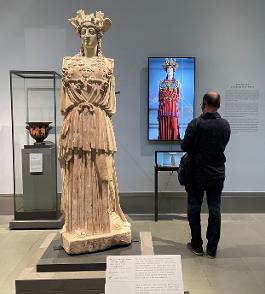
A view of the statue of Athena Parthenos and interactive panel showing a new 3-D digital reconstruction in the recently revamped George D. and Margo Behrakis Wing for Art of the Ancient World at the Museum of Fine Arts, Boston (MFA).
Image © Meredith Binnette
First paper of the special issue on "Polychromy in Sculpture and Architecture" in Heritage has been published!
"Portrait of an Etruscan Athletic Official: A Multi-Analytical Study of a Painted Terracotta Wall Panel"
Monica Ganio, Douglas MacLennan, Marie Svoboda, Claire Lyons and Karen Trentelman from the Getty Conservation Institute and The J. Paul Getty Museum (Los Angeles, USA).
Read free and open-access here: https://doi.org/10.3390/heritage4040253
Published - 28/10/2021.
Added: 28/10/2021.
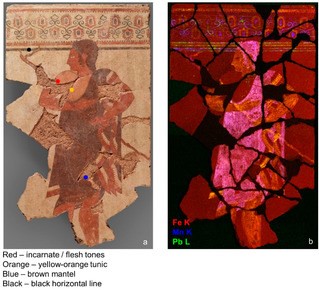
News from the Städelmuseum and Liebieghaus Skulpturensammlung, Frankfurt am Main.
A workshop on the subject, "Colour matters. Polychromy of Ancient Greek and Roman Sculpture as Research Subject in Archaeology and Philology" was held on Friday 24th September 2021, to coincide with the closing of the exhibition ‘Bunte Götter – the Golden Edition’ at the Liebieghaus. See the workshop programme here.
Jan Stubbe Østergaard has kindly put together some notes on his impressions of the meeting. Read them here.
Added: 14/10/2021
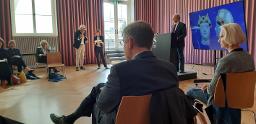
Paolo Liverani (speaking), in the background; Vinzenz Brinkmann and Clarissa Blume-Jung (both standing) and Ulrike Koch-Brinkmann (sitting) . In the foreground; Oliver Primavesi (left) and Christiane Vorster (right).
Image © Jan Stubbe Østergaard
Technical colour survey at the Kelsey Museum of Archaeology
Conservators Carrie Roberts and Suzanne Davis are in the midst of a two-year grant-funded project to characterize pigments and dyes on Roman Egyptian artifacts at the Kelsey Museum at the University of Michigan. This NEH-funded project will incorporate multiband imaging and XRF analysis of sculpture, ceramics, textiles, and wall painting fragments from Karanis and Terenouthis, two Roman Egyptian sites excavated by University of Michigan in the 1920s and 30s.
The goals of this project are twofold: to make initial pigment and dye characterizations on up to 200 artifacts with known provenance, gathering data that can be immediately linked to known archaeological sites; and to develop a set of online research tools that can be easily replicated in other small museums like ours. By looking at our collection with tools that are familiar to archaeologists, we hope to explore trends in Roman Egyptian color use while also making technical color research more accessible. We’ve made some interesting discoveries so far, including painted funerary inscriptions only visible under UV; evidence of pigment mixtures and double-dying; and an unexpected green colorant on a well-documented ancient artifact. We look forward to sharing our full results—and accompanying research toolkit—on the Kelsey Museum’s website in early 2023.
Added: 28/09/2021
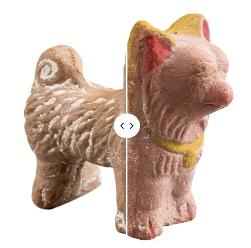
KM 3768, painted terracotta figurine from Karanis, Egypt, 1st – 5th centuries CE. Image © Kelsey Museum.
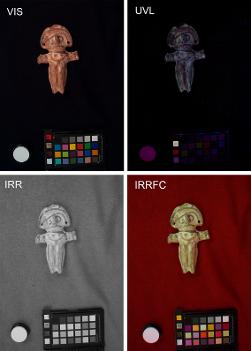
Examining a group of polychrome funerary stelae from Terenouthis, Egypt, late 2nd – early 4th centuries CE. Image © Kelsey Museum.
News from the Getty - The APPEAR (Ancient Panel Paintings, Examination, Analysis and Research) Project, Publication and Second Conference in 2022!
In 2013, the Antiquities Conservation Department at the J. Paul Getty Museum launched an international collaboration known as APPEAR: Ancient Panel Painting, Examination, Analysis and Research. Focused on the study of the materials and manufacturing practices of ancient mummy portraits from Roman Egypt, the APPEAR project is a collaboration of forty-nine partner institutions and eleven advisory consultants from different archaeological and archaeometric backgrounds. Participation in the project encourages the exchange of comparative visual, historical and technical information through a database platform for sharing among scholars world-wide to develop research paths, and recognize trends and anomalies. The value of identifying and comparing the materials used to create these exceptionally well-preserved painted artifacts, specifically pigments and binding media, directly benefits the broader understanding of polychromy in the ancient world. Through conferences, publications and keeping the subject at the forefront of ancient material studies, the APPEAR project will remain a unique resource for years to come.
Conferences and Publication Information
In 2018 an international conference was organized at the Getty Villa providing an opportunity for participants to present their research; the papers were published in 2020 online and can be accessed here:
https://www.getty.edu/publications/mummyportraits/
The APPEAR project will conclude in 2022 with a second meeting hosted by the Allard Pierson Museum in Amsterdam. For information on the project and updates, please visit:
https://www.getty.edu/museum/conservation/APPEAR/index.html
Added: 09/09/2021
Reminder - Special issue of Heritage on "Polychromy in Ancient Sculpture and Architecture" *FREE OF CHARGE* until 31 August 2021.
This special issue will collect contributions to the 9th Polychromy Round Table but also invites articles from researchers who may be considering ancient polychromy from the Greco-Roman world & comparative studies from their own interdisciplinary viewpoints, geographical areas & time periods.
For more information, see:
https://www.mdpi.com/journal/heritage/special_issues/polychromy_sculpture_architecture
All submissions until 31 August 2021 will be published open-access & *FREE OF CHARGE*
Added: 25/06/2021
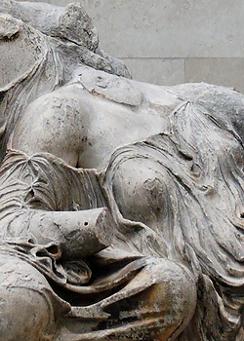
Update on the MSCA funded project, "Colorful Indications of (Ex)Change" - Noricum in the Roman Imperial period and Late Antiquity
In September 2020, Dr. Alexandra S. Rodler, a post-doctoral fellow at the Austrian Archaeological Institute of the Austrian Academy of Sciences, was awarded a European Commission’s Marie Sklodowska-Curie Fellowship for a period of two years, to investigate the provenance of pigments used for Roman wall paintings, as well as pigment production and organization of production. The project aims to test whether local production was relevant or importation can be linked to material quality, whether specific source regions and trade contacts can be identified and if supply and technology changed over time, between sites and across regions.
With a focus on wall paintings, specifically cinnabar and Egyptian blue pigments, including their archaeological and historical context as well as mineralogical and geochemical information, this project tests the potential of ancient pigments as powerful indicators of trade, cultural and technological exchange during Roman Imperial period and Late Antiquity in Noricum after it became part of the Roman Empire. This will be compared to contemporary samples from central Italian sites.
These wall painting fragments and raw pigments are first characterized by in-situ pXRF analysis at local museum collections to identify samples for further mineralogical and geochemical analysis at the University of Vienna and collaborating institutions. Parallel to the pigment analysis, potential raw materials for pigment production are also analysed and will be integrated into a provenance map.
To follow the project and learn more about the team and the institutions involved, see: https://alexandrasrodler.com/colorinxchange/ or follow on https://twitter.com/ColorinXchange
This project has received funding from the European Union’s Horizon 2020 research and innovation programme under the Marie Skłodowska-Curie grant agreement No 845075.
Added: 03/06/2021
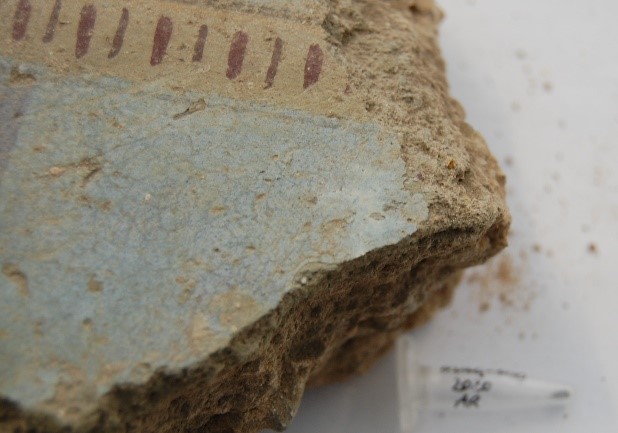
Wall painting fragment with Egyptian blue.
Image © A.S. Rodler (Austrian Academy of Sciences).
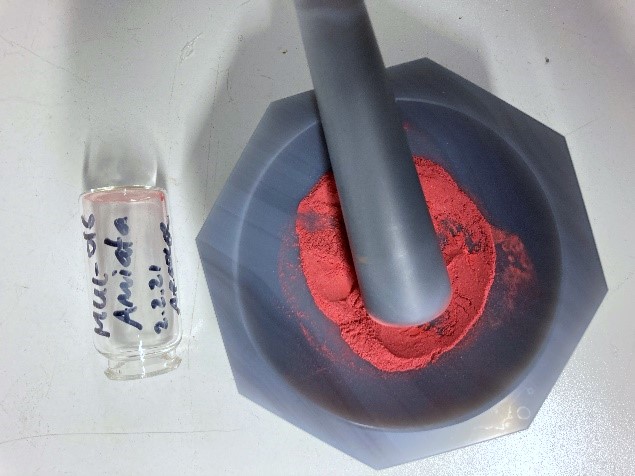
Cinnabar ore from Monte Amiata, Italy.
Image © A.S. Rodler (Austrian Academy of Sciences).
Honouring Susanna Bracci
It is with great sadness that we announce the passing on April 26 of our beloved friend and colleague Susanna Bracci who served as Senior Researcher at the National research Council in Florence for over thirty years.
Susanna was a prominent Conservation Scientist, a highly respected figure in the Heritage Science world at national and International level.
She was an active member of the Polychromy Round Table family, sharing with many of us her research in the field of ancient polychromy, focusing on non-invasive approaches for the study of painted surfaces.
Her close working relationships with scientists, curators, conservators, scholars and students, and her incredible artistic sensitivity, made her an excellent colleague. Everyone who worked with Susanna, including the many students, would agree that Susanna’s remarkable expertise was equaled by her pleasant and positive personality, contagious to everyone she met.
In recent years, in addition to her professional and human skills, we have also admired the strong courage and determination in facing life challenges due to her personal battle with illness.
We will truly miss Susanna, her formidable intelligence and tireless dedication.
Added: 13/05/2021
Susanna during an analytical campaign on Last Supper by Plautilla Nelli, 2016. Image courtesy of Linda Falcone, AWA Advancing Women Artists.
Update on the MSCA project, "The Painted Tetrarchic Reliefs of Nicomedia"
In 2019, Dr. Tuna Şare Ağtürk, an associate professor of classical art and archaeology at Çanakkale 18 Mart University, was awarded a European Commission’s Marie Sklodowska-Curie Fellowship at Oxford University to prepare the first major publication of a series of painted marble frieze panels from an imperial complex recently found in Nicomedia (Izmit-Turkey), administrative capital of the Eastern Roman Empire during the Tetrarchy.
The sixty-six relief panels of the Nicomedia frieze represent an astonishing combination of imperial, mythological, and agonistic scenes. The excellent preservation of colour on the frieze is unprecedented in the corpus of Roman state relief sculpture. As the only extant imperial monument which preserves extensive applied polychromy, the frieze offers new, key insights into many technical aspects of sculptural polychromy, such as the application of colour and visibility, and the painter’s role in sculpture. Furthermore, an iconographical approach to the polychromy of the Nicomedia reliefs helps in the understanding of aspects of increasingly prevalent colour-coding in the imperial art of the later third century. The initial polychromy investigation of the reliefs, which included multispectral and microscopic imaging and pXRF analysis, has been conducted in a TÜBİTAK-supported collaborative investigation by Şare Ağtürk and Dr. Mark Abbe of University of Georgia.
Şare Ağtürk’s book ‘The Painted Tetrarchic Reliefs of Nicomedia’ will be published by Brepols later in 2021.
To follow the project and learn more about the team, the institutions involved, and the related publications see:
https://cukurbagarchaeologicalproject.com/
Added: 29/04/2021
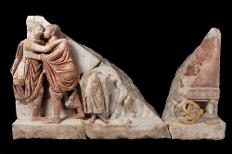
Image © Çukurbağ Archaeological Project, Kocaeli Archaeology Museum.
New Conservation Scientist appointed at the Ny Carlsberg Glyptotek
Jens Stenger started an appointment at the Ny Carlsberg Glyptotek in Copenhagen on March 1 this year, to join the research project on ancient polychromy, led by Cecilie Brøns and financed by the Carlsberg Foundation. He is a physicist by training and has previously held positions at the Cologne Institute for Conservation Sciences, the Swiss Institute for Art Research, Yale’s Institute for the Preservation of Cultural Heritage, and the Harvard Art Museums. At Harvard, he worked on the non-invasive colour restoration of Mark Rothko’s Harvard Murals using light from a digital projector. Jens’ research interests include colour and light, combining imaging techniques and chemical analysis, technical art history, and modern materials. He will join New York University’s Institute of Fine Arts as an Assistant Professor of Conservation Science in the Spring semester, 2022.
Added: 19/04/2021

Image © Jens Stenger
"PolyCRomA" - The meaning of colour in Roman Africa
In November 2020, Dr Elisabetta Neri, a post-doctoral fellow at the atomic and nuclear spectroscopy laboratory at the University of Liège, was awarded a European MSCA Individual Fellowship for a period of two years, in order to study the significance of the polychromy of Roman imperial statues (1st-4th century AD), on an unprecedented scale.
The project, named “PolyCRomA”, proposes the first systematic study of the use of colour in the statuary of an important Roman province, and will consider 20 statues from the collections of the Bardo museum in Tunisia. The variety of typologies, qualities and provenances (local, Asia Minor, Rome) of the statues in this corpus holds up a mirror to African society of the period. Moreover, as the archaeological context of discovery is well known, the meaning of the polychromy will be analysed in relation with the socio-political and religious purpose with which these artefacts were conceived. The preserved traces of colour will first be documented by coupling visual investigation (with the support of multispectral imaging and UV and VIL videomicroscope) and in-situ analyses (XRF and μRaman) in order to identify the techniques used to colour the statues. Selected micro-samples will undergo further quantitative analyses (PIXE, SEM/EDX, hyperspectral imaging, FT-IR). Finally, literary and epigraphic sources of Proconsular Africa mentioning the colour of statues will be inventoried and the use of colour on the statues will be compared with their counterparts in painting and mosaic.
To follow the project and learn more about the team and the institutions involved, see:
https://www.polychroma.uliege.be/cms/c_6264927/en/polychroma
Added: 08/04/2021
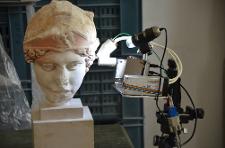
Image © PolyCRomA (University of Liège).
"ECOValors" - A new phase for the "MANN in Colors" project
"MANN in Colors", is a research project established in 2018 to study the polychromy of masterpieces of Classical sculpture at the Museo Archeologico Nazionale di Napoli (MANN).
After three successful years, including staggering findings from important pieces of sculpture such as the famous, “Venus in a bikini” statuette and the "Venus marina" from Pompeii (pictured), the project will now enter a new two-year phase, via a prestigious collaboration that will unite the National Archaeological Museum of Naples and the Department of Chemical Sciences and Technologies of the University of Rome "Tor Vergata".
This phase of the project entitled, "ECOValors" (Eco-Sustainable project for Conservation and Valorization of colour traces on Marble sculptures), will take as its point of departure the analytical results obtained by Cristiana Barandoni (creator and scientific curator of the "MANN in Colors" project) and Andrea Rossi (responsible for the diagnostic investigations). The team from the University of Rome, which uses sustainable methodologies, or “Green Chemistry”, for its investigations into issues such as, air quality and pollutants, in relation to cultural heritage, will participate in the creation of a protocol for the conservation and protection of works on whose surfaces traces of colour have been discovered. It is hoped that the creation and dissemination of such a protocol will help institutions worldwide to safeguard the remains of polychromy on their sculpture from environmental effects, for the enjoyment of future generations.
Added: 29/03/2021
The "Venus in a bikini" (left): recent investigations have shown green pigments present on the tree trunk. The dress of the goddess was also originally embellished with rose madder (right), Egyptian blue and gold.
Image © Museo Archeologico Nazionale di Napoli (MANN).
The "Venus Marina" (left): the statue was irradiated with ultraviolet light and the resulting pink luminescence (right) is an unequivocal sign of the ancient use of rose madder.
Image © Museo Archeologico Nazionale di Napoli (MANN).
"Therapéia. Polychromie et restauration de la sculpture dans l'antiquité" (Technè vol. 40, 2014, ed. by B. Bourgeois) is now open access!
This richly illustrated volume deals with polychrome sculpture and its conservation in Antiquity. It explores this important yet obscure topic in an interdisciplinary manner, by combining literary, epigraphic and archaeological data with results of in-depth scientific investigation. The love for colour and the care taken in keeping valuable objects in pristine condition, particularly by way of repainting, re-gilding, waxing (ganôsis) is thus demonstrated on objects of various historical contexts: Egyptian wood furniture, Cypriot limestone portraits, ivory sculptures from Macedonian chryselephantine klinai, Greek terracotta figurines, Ptolemaic royal marble head of Berenike II etc. Several of the case-studies deal with objects kept in the Antiquities departments of the Louvre museum.
For open access go to: https://journals.openedition.org/techne/2943
Added: 16/03/2021
Special issue of Heritage on "Polychromy in Ancient Sculpture and Architecture"
The Call for papers is now OPEN for this special issue, which will collect contributions to the 9th Polychromy Round Table & also invites articles from researchers who may be considering ancient polychromy from the Greco-Roman world & comparative studies from their own interdisciplinary viewpoints, geographical areas & time periods.
For more information, see:
https://www.mdpi.com/journal/heritage/special_issues/polychromy_sculpture_architecture
The deadline is 31st December 2021.
Added: 19/02/2021
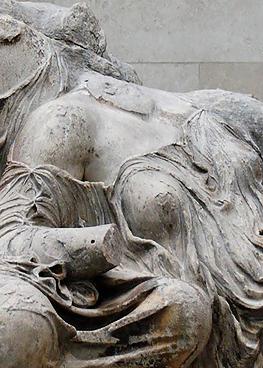
New publication - Technè Journal, vol. 48
The 8th International Round Table, held at the C2RMF in Paris, on 15-16 November 2016, has been published in Technè Journal, vol. 48, 2019.
The printed volume may be purchased online at https://www.lcdpu.fr/revues/techne/ & will be open access from July 2021 at https://journals.openedition.org/techne/
Added: 16/12/2020
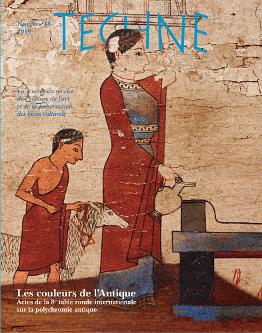
Remembering Ian Jenkins
The news of the death of Ian Jenkins (Curator in the Department of Greece and Rome at the British Museum), who passed away on 28th November 2020, was received by all with great sadness.
Ian will be remembered by so many as a dear colleague, mentor and friend who gave his whole working life to the British Museum in a distinguished career which spanned more than 42 years. He was passionate about the study of polychromy in ancient Greek sculpture and architecture.
The following obituaries for Ian have recently been published:
The Telegraph describes Ian as the British Museum curator who opposed calls to return the Elgin marbles to Greece. https://www.telegraph.co.uk/obituaries/2020/12/07/ian-jenkins-british-museum-curator-opposed-calls-return-elgin/
The Guardian publishes an obituary for Ian Jenkins written by former British Museum Deputy Director, Andrew Burnett. https://www.theguardian.com/artanddesign/2020/dec/15/ian-jenkins-obituary
The Times obituary describes Ian as ‘Curator at the British Museum and revered expert on ancient Greece who staunchly opposed calls to return the Elgin Marbles’. Full obituary here.
The Art Newspaper's is written by Susan Walker who describes Ian as ‘a scholar and British Museum curator who enriched all who met him with his passion for classical Greece’. https://www.theartnewspaper.com/feature/ian-jenkins-british-museum-obituary
ARTnews also published an obituary for Ian writing, ‘Jenkins joined the British Museum in 1978 and wound up shaping how ancient Greek art was presented there. As a classics scholar, he was concerned with how the presentation of such architectural works within the museum’s galleries informed the viewer’s perspective...'. https://www.artnews.com/art-news/news/ian-jenkins-british-museum-curator-dead-1234579601/
Ian Dennis Jenkins, classical scholar and archaeologist, born 18 February 1953; died 28 November 2020.
Added: 16/12/2020
